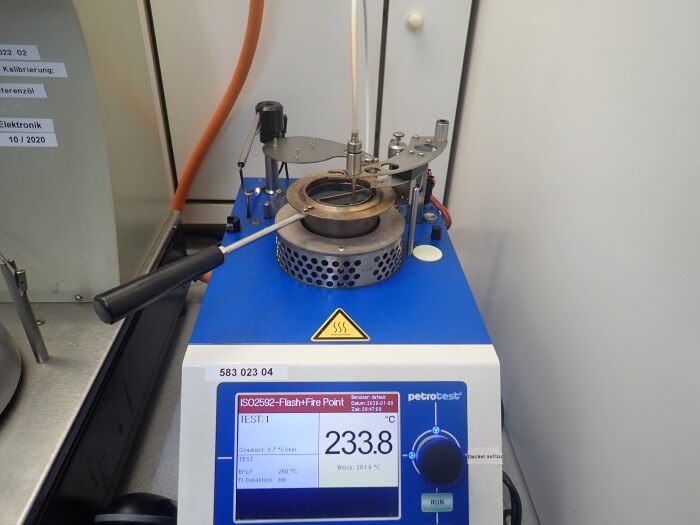


What is the flash point of oil?
The flash point for oil is the lowest temperature at which an oil sample develops sufficient vapours under specified conditions for the air-vapour mixture above the sample to ignite for the first time without continuing to burn afterwards.
If the oil-air mixture burns for at least five seconds or longer, this is referred to as the focal point of the oil. The focal point is usually only a few degrees Celsius above the flash point.
The flash point alone is not a sufficient quality feature of oil, nor does it allow conclusions about the suitability of the oil. It is also not draw any conclusions on the oil consumption in combustion engines from this.
How is the flash point of oil determined?
Since the flash point is an important constant for lubricants of all kinds, each oil is tested with regard to its flash point. The flash point contributes significantly to the scope of application of a lubricant. Of course, no oil with a flash point of 150 °C can be used in a system where peak temperatures of over 150 °C are reached. The risk of fire and explosion would be too high.
Oils with a flash point above 79 °C are determined according to ISO 2592 in an open crucible according to Cleveland. Oils with a lower flash point are determined in closed crucibles according to Abel-Pensky (DIN 51755) or Pensky-Martens (DIN 51758). The standardized test procedures ensure constant basic requirements and ambient conditions. Thus, the flash points of different oils are well comparable.

When is the flash point of oil reached?
Each oil has a different flash point. Depending on the application, a certain flash point may also be required. Basically, it can be said that the flash point of paraffin-based oils with a density between 860 and 890 kg*m-3 is between 200 and 280°C. For naphthene-based oils with a density between 890 and 960 kg*m-3 flash points of 235 °C and lower are reached.
In the case of engine oils for passenger cars, flash points of 200 °C to 270 °C are usually achieved. The engine oils of ADDINOL have a flash point of more than 200 °C.
Some special oils for industrial applications can reach flash points above 300 °C.
Why does the flash point of oils sometimes drop during use?
Particularly in combustion engines, the oil may mix with fuel after prolonged periods of use, resulting in oil dilution. The entry of foreign substances, fuel or water is also the reason why the flash point of other oils could drop. If the flash point of the oil sample falls below 150 °C, the oil should be changed to reduce the risk of fire.
Flash point comparison between grease and oil
In contrast to oil, the determination of the flash point is not so important for lubricating greases. In the case of greases, the dropping point is one of the most important properties. The dropping point is the temperature at which the grease begins to leak. This means that the thickener can no longer bind the oil and the fat liquefies. Once the dropping point of a lubricating grease has been reached, it can no longer maintain the lubricating film as desired. High temperature greases can reach dropping points of approx. 300 °C.
Flash point of 2-stroke engine oil
Since many 2-stroke oils are burned as a result of mixed lubrication in the engine compartment in conjunction with the fuel, the flash points of 2-stroke oils are usually lower than the flash points of normal engine oils for cars. The flash point of some 2-stroke oils is approximately 130 °C.
However, there are also 2-stroke oils without premix components with a higher flash point. Especially for racing motorcycles, the flash point of the oil is a quality feature, as the oil burns more slowly and the additives protect the engine longer. ADDINOL POLE POSITION HIGH SPEED 2T has proven itself for use in racing motorcycles. The flash point is at least 270 °C.
Examples of high temperature lubricants from ADDINOL
ADDINOL offers many special oils which have a particularly high flash point to withstand high temperature conditions. We have compiled some examples of our oils with their associated flash points, including oils for high temperature applications.
| ADDINOL oil | Flash point | Application |
| ADDINOL SUPER 2T MZ 406 | >135 °C | Oil for two-stroke engines |
| ADDINOL HEAT TRANSFER OIL XW 15 HT | 200 °C | Heat transfer medium |
| ADDINOL SUPER LIGHT 0540 | >235 °C | Engine oil for passenger cars |
| ADDINOL POLE POSITION HIGH SPEED 2T | >270 °C | Oil for two-stroke engines without premix components |
| ADDINOL CLIPTEC XHS 150 HT | >280 °C | Chain lubricant for high temperature applications |
| ADDINOL SPECIAL OIL XH 220 A | >285 °C | Lubrication of conveyor technology in high-temperature plants |
| ADDINOL ECOSHIELD HF-FR 68 | 298 °C | Hydraulic oil for high temperature applications |
Contact
